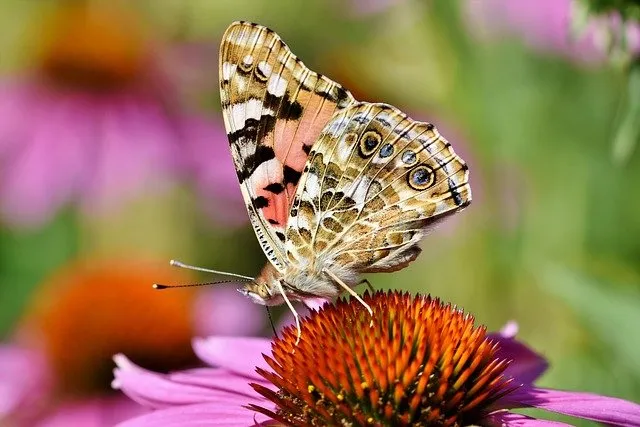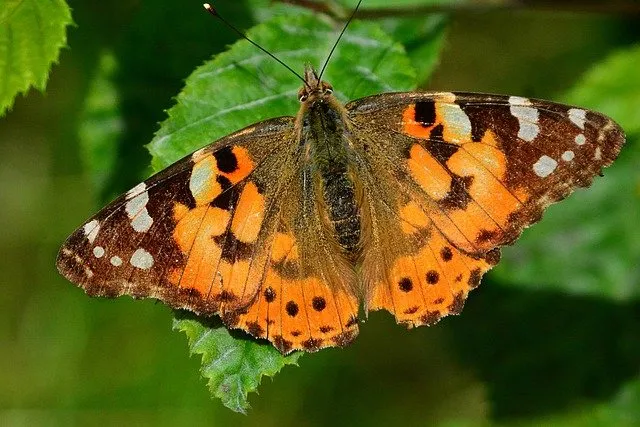As an Amazon Associate I earn from qualifying purchases.
Welcome to our blog, where we embark on a fascinating journey to uncover the culinary secrets of one of nature’s most enchanting creatures – the painted lady butterfly. Among the vibrant tapestry of the insect world, painted ladies, scientifically known as Vanessa Cardui, stand out for their stunning orange and black wings. As we delve into the captivating world of these delicate insects, one question that often arises is, “What do painted lady butterflies eat?”
This blog post aims to answer that question comprehensively, unveiling the various dietary preferences that sustain these beautiful creatures throughout their remarkable life cycle. From nectar-sipping adults to leaf-munching caterpillars, join us as we explore the diverse and intriguing menu of painted lady butterflies.
What Do Painted Lady Butterflies Eat?
Painted lady butterflies, scientifically known as Vanessa cardui, are one of the world’s most widespread and recognizable butterfly species. These delicate insects are known for their vibrant orange and black wings, making them a favorite among butterfly enthusiasts and nature lovers. But have you ever wondered what fuels these beautiful creatures? Whether you’re a butterfly enthusiast or curious about nature, this guide will provide valuable insights into their feeding habits.
1. Nectar from Flowers:
The primary source of sustenance for adult painted lady butterflies is nectar from various flowering plants. These highly mobile butterflies can cover large distances during their migrations, so they rely on the energy-rich nectar to fuel their flights. Some of their favorite nectar-producing flowers include:
Thistles: Painted ladies are particularly fond of thistle flowers, which provide ample nectar. These tall, spiky plants are a common sight in meadows and fields.
Milkweed: Milkweed plants are a food source for painted ladies and serve as host plants for their caterpillars. The nectar from milkweed flowers is rich in nutrients.
Aster: Asters are a late-season favorite for painted ladies, providing them with nectar well into the fall. Their colorful, daisy-like blooms are irresistible to these butterflies.
Sunflowers: Sunflowers are known for their large, attractive flowers that contain abundant nectar, making them a popular choice for painted lady butterflies.
2. Tree Sap and Rotting Fruit:
Apart from nectar, painted lady butterflies also feed on tree sap and the juices of rotting fruits. These alternative food sources can be especially vital when nectar-producing flowers are scarce. While tree sap and rotting fruit might not be as commonly associated with butterflies as nectar, they are essential for providing additional nutrients.
3. Caterpillar Diet:
Before they become beautiful butterflies, painted lady larvae (caterpillars) have unique dietary needs. The caterpillars feed on the leaves of specific host plants, including:
Thistles: Young painted lady caterpillars often feed on the leaves of thistle plants, which are rich in nutrients and provide a suitable environment for their growth.
Mallows: Mallow plants, like the common mallow (Malva neglecta), are also host plants for painted lady caterpillars. The leaves of these plants serve as nourishing food for the developing larvae.
Nettles: Stinging nettles are another host plant for painted lady caterpillars. Despite their stinging hairs, these plants are a valuable food source during the early stages of a painted lady’s life cycle.
How To Feed Painted Lady Butterflies As A Pet?
Feeding painted lady butterflies as pets can be a rewarding and educational experience, especially for children and enthusiasts interested in observing the butterfly life cycle up close. To feed painted lady butterflies effectively, you must provide them with suitable food, maintain appropriate living conditions, and follow a few essential steps. Here’s a guide on how to do it:
1. Obtain Painted Lady Butterfly Caterpillars or Chrysalides:
You can usually purchase painted lady butterfly caterpillars or chrysalides from reputable suppliers or butterfly farms. Ensure that they are obtained legally and ethically, as some regions have regulations on butterfly collection.
2. Set Up a Butterfly Enclosure:
Prepare a suitable enclosure to house your painted lady butterflies. A mesh or netted butterfly cage or pen is ideal for proper ventilation. Ensure that the enclosure is large enough to accommodate your butterflies comfortably.
3. Provide Nectar Sources:
As adult butterflies, painted ladies primarily feed on nectar from flowering plants. You can offer them a nectar source by placing fresh flowers in the enclosure. Familiar nectar sources include:
- Cut flowers like zinnias, asters, marigolds, and daisies.
- Potted flowering plants (non-toxic to butterflies) like butterfly bush (Buddleia), pentas, or lantana.
- Change the flowers regularly to ensure a fresh nectar supply.
4. Offer Sugar Water:
In addition to fresh flowers, you can provide a sugar water solution as an additional source of nourishment. Mix a solution of 10% sugar to 90% water and saturate a clean sponge. Place the sponge in a shallow dish inside the enclosure. Ensure that the dish is not too deep to prevent drowning.
5. Provide Overripe Fruit:
Painted lady butterflies may also feed on overripe fruit. Offer small slices of ripe fruit like oranges, melons, or apples. Place these slices on a shallow dish and replace them daily to prevent mold or bacterial growth.
6. Maintain Proper Hydration:
Butterflies need moisture for survival. You can lightly mist the inside of the enclosure with water using a spray bottle to provide humidity and ensure the butterflies can drink droplets from plant leaves or other surfaces.
7. Release and Restock:
Painted lady butterflies have a relatively short lifespan (a few weeks), so releasing them into their natural habitat when they emerge from the chrysalids is essential. This allows them to complete their life cycle and reproduce. If you wish to continue raising painted lady butterflies, you can obtain new caterpillars or chrysalides to start the process again.
8. Maintain Cleanliness:
Regularly clean the enclosure to remove waste and spoiled food to prevent the growth of harmful bacteria or mold. This helps maintain a healthy environment for your butterflies.
9. Learn and Observe:
Take the opportunity to learn about the painted lady butterfly’s life cycle and behavior as you raise them. Document their development and behavior to better understand these fascinating insects.
How Painted Lady Butterflies Impact Our Ecosystem?
Painted lady butterflies have a significant impact on our ecosystem in several ways. These impacts touch upon various aspects of the environment, from pollination to their role in the food web. Here’s a detailed look at how painted lady butterflies influence our ecosystem:
1. Pollination:
Painted lady butterflies are important pollinators. As they visit flowers searching for nectar, their bodies come into contact with pollen grains, which they inadvertently transfer from one flower to another. This process facilitates the fertilization of plants, allowing them to produce seeds and fruits. Many plant species rely on pollinators like butterflies to reproduce, and without them, these plants would decline, affecting the entire ecosystem.
2. Biodiversity:
The presence of painted lady butterflies contributes to biodiversity. Their interactions with various flowering plants create a diverse and interconnected species network. Pollinating different flowers helps sustain the plant communities that support other wildlife, including insects, birds, and mammals.
3. Food Source:
Painted lady butterflies serve as a crucial food source for a wide range of predators in the ecosystem. Birds, spiders, ants, and other insects consume their caterpillars. Likewise, adult butterflies are part of birds‘ diet, particularly those specializing in feeding on flying insects. This predation helps maintain the balance of species in ecosystems.
4. Indicator Species:
Painted lady butterflies can act as indicator species, reflecting the health of their habitat. When their populations thrive, it signifies a stable and diverse ecosystem with abundant flowering plants. Conversely, a decline in their numbers can indicate environmental stressors, such as habitat loss or pesticide use, which may also affect other species in the ecosystem.
5. Seed Dispersal:
While painted lady butterflies primarily feed on nectar as adults, they occasionally consume tree sap and rotting fruit. This behavior can contribute to seed dispersal. By feeding on fruits and sap, they may inadvertently pick up seeds and transport them to new locations, helping plants colonize different areas and contributing to the overall distribution of plant species.
6. Ecological Interactions:
Painted lady butterflies participate in various ecological interactions that shape their ecosystem. For instance, they engage in mutualistic relationships with certain nectar-producing plants, benefiting both themselves and the plants. Additionally, their interactions with other insects, such as ants that protect caterpillars from predators, demonstrate the complexity of ecological webs.
7. Economic Value:
Beyond their ecological significance, painted lady butterflies can also have economic value. They attract tourists and butterfly enthusiasts to specific regions, promoting ecotourism and local economies through butterfly-watching activities and gardens.
Final Words
In conclusion, our exploration of painted lady butterflies has unraveled the question, “What do painted lady butterflies eat?” These stunning insects, known for their vibrant orange and black wings, have a multifaceted diet that shifts throughout their life cycle. From nectar-sipping adults that contribute to pollination to leaf-munching caterpillars reliant on specific host plants, painted lady butterflies play a significant role in our ecosystem. They aid in plant reproduction, support biodiversity, and serve as crucial elements in the intricate web of life.
You can also read:
1. A Lovebird’s Culinary Delight: What Do Lovebirds Eat?
2.What Do House Wrens Eat? Insectivores of the Garden
3.What Do Hippopotamuses Eat? Dining with Giants
4.What Do German Shepherds Eat? Feeding Your Furry Guardian
Amazon and the Amazon logo are trademarks of Amazon.com, Inc, or its affiliates.



